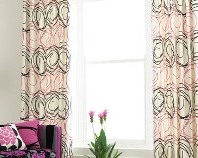Warren McArthur
 December 26, 2007
December 26, 2007  Designer We Love: Warren McArthur Jr.
Designer We Love: Warren McArthur Jr.
Quotable Quote: ". . . the reward of something rare and special—like a vintage Warren McArthur chair" (Michael Webb, Architectural Digest, April 2001)
Background
Born in 1885 and grew up in Chicago, IL
Well-to-do upbringing, with dad hiring Frank Lloyd Wright to design their family home in 1892 (one of Wright's earliest commissions, before he struck out on his own)
Studied mechanical engineering and graduated from Cornell in 1908
 Designed lamps from 1911 to 1914 for a lantern company that his father headed up sales for; had various jobs and lots of support from his father to design and produce patents (had 10 patented lamp designs)
Designed lamps from 1911 to 1914 for a lantern company that his father headed up sales for; had various jobs and lots of support from his father to design and produce patents (had 10 patented lamp designs)
Moved to Phoenix, AZ to work with his brother Charles
Started 12 car dealerships and developed an adapter for car radiators to prevent overheating in desert climate
He and Charles created the "Wonder Bus," considered an early recreational vehicle, to promote tourism and visiting National Parks via the new U.S. highway system
Warren and Charles started the first AZ radio station, founded the Arizona Museum, and worked on the Arizona Biltmore resort which was designed by Arthur, their older brother
With his father's financial backing, made a 1929 move to LA to start a metal furniture business, with focus on aluminum and special ways to join standard metal pieces together
 Developed a process to make aluminum hard, impossible to tarnish -- backed by a lifetime guarantee
Developed a process to make aluminum hard, impossible to tarnish -- backed by a lifetime guarantee
Developed a coloring process, adding color into the porous aluminum, then sealing it in as part of the metal versus an outer coating (see his Rainbow Chair, photo just below)
Warren McArthur Corporation's curvy Art Deco furniture became a huge hit with film stars, and waves of furniture showed up in movies, in theaters, hotels, and residential design projects
His refined metal curves helped popularize the streamlining and Moderne style
Designed bomber aircraft seating during World War II
Beset with financial woes after his father died, McArthur moved to Rome, New York in 1933 to manufacture his lines, with over 600 exclusive designs
His company closed its doors in 1948 and McArthur died in 1961
 What We Love
What We Love
We're intrigued by his father's constant financial support of his son's early career pursuits, and wish all parents were as supportive of their children's artistic and design sensibilities and projects
His pioneering spirit and devotion to technology and design innovation -- from a mechanical engineering background and fascination with the car (his family was one of the first to own a car in Chicago), he kept innovating away
McArthur's sense of color, producing cool tones of aluminum with great names like Grenadine, Alice Blue, and Golf Green, then pairing them with upholstered fabrics that featured contrasting colors like red and canary yellow or red and ebony
His design chic defined glamorous Hollywood of the 1930s
Thank this man for the outdoors chaise lounge, which he called "dripping chairs that would stand the test of sun and rain"
We love his folding chairs!
Warren McArthur Sampler







Photo Credits: Antiques and the Arts, DesignGallery, Carnegie Museum of Art, Washington Post, Reside, Rago Arts, Philips de Pury & Co., artnet
 Design2Share
Design2Share
Design2Share marks the passing of Warren McArthur III in late April 2008. McArthur's family is steeped in national design history -- and long controversies, and sexy chairs. In turn-of-the-century Chicagoland McArthur's grandfather (Warren I) commissioned one of Frank Lloyd Wright's illicit "bootleg" houses; his three sons (Albert, Charles, and Warren II) grew up in that experimental atmosphere, and moved to Phoenix Arizona separately in the 1910s and 1920s. Albert worked for Wright for awhile, and is best known for his disputed credit for the 1929 Arizona Biltmore, a bit of confusion that Warren III took it upon himself to correct.
But that's not the good part. Bankrolled by their father, Warren and Charles were very busy in early Phoenix. They developed the Biltmore as a resort, founded the city's first radio station and a dozen automobile dealerships, redesigned automobiles for desert conditions, and invented the "Wonderbus." And Warren II, to save money furnishing his father's Phoenix vacation home, invented tubular metal furniture here in 1924, two years before Mart Stam and Marcel Breuer and Mies began experimenting with it in 1926. Just dig that idea for a moment. And that furniture went into the Biltmore.
The Depression sent Warren II to southern California, where his burnished-aluminum, steel-stiffened, ridiculously glamorous furniture became the perfect match for the Hollywood Moderne star-houses from architects like Rudolph Schindler and Paul Williams. Clark Gable sat here. Then from 1993 to 1948 Warren II produced furniture in New York, taking big government contracts during the war for lightweight aircraft seating. Prescient as an industrial designer, Warren II tinkered with the aluminum mix for better surface and durability, and went as far as tinting the metal. But his sense of color and proportion and line are -- well, just take a look. Increasingly known to collectors, if a McArthur chair comes within your reach? Buy it.

![]() Our thanks to Arizona architectural writer extraordinaire Walt Lockley for this obituary piece on Warren III. Visit Walt's website to see the amazing -- and underappreciated -- Biltmore bungalows (see photo above).
Our thanks to Arizona architectural writer extraordinaire Walt Lockley for this obituary piece on Warren III. Visit Walt's website to see the amazing -- and underappreciated -- Biltmore bungalows (see photo above).
 Warren McArthur,
Warren McArthur,  aluminum,
aluminum,  furniture in
furniture in  designer
designer 











